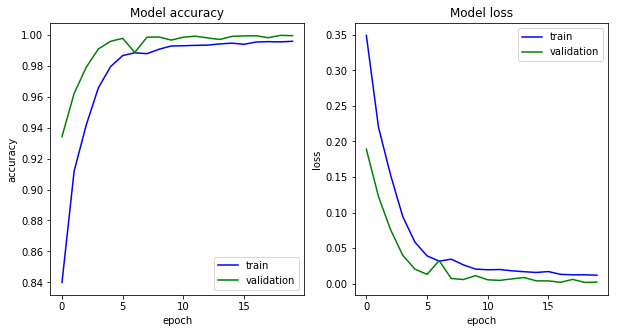利用TextCNN对IMDB Reviwe文本进行分类,数据集地址:https://pan.baidu.com/s/1EYoqAcW238saKy3uQCfC3w
提取码:ilze
import numpy as np
import logging
from keras import Input
from keras.layers import Conv1D, MaxPool1D, Dense, Flatten, concatenate, Embedding
from keras.models import Model
# from keras.utils import plot_model
from keras.utils.vis_utils import plot_model
import pandas as pd
import warnings
import keras
import re
import matplotlib.pyplot as plt
from nltk.stem import WordNetLemmatizer
from nltk.corpus import stopwords
from keras.preprocessing.text import Tokenizer
from keras.preprocessing.sequence import pad_sequences
from keras.layers import Dense, LSTM, Embedding, Dropout, Conv1D, MaxPooling1D, Bidirectional
from keras.models import Sequential
from keras.utils import np_utils
warnings.filterwarnings('ignore')
# get data
df1 = pd.read_csv('word2vec-nlp-tutorial/labeledTrainData.tsv', sep='\t', error_bad_lines=False)
df2 = pd.read_csv('word2vec-nlp-tutorial/imdb_master.csv', encoding="latin-1")
df3 = pd.read_csv('word2vec-nlp-tutorial/testData.tsv', sep='\t', error_bad_lines=False)
df2 = df2.drop(['Unnamed: 0','type','file'],axis=1)
df2.columns = ["review","sentiment"]
df2 = df2[df2.sentiment != 'unsup']
df2['sentiment'] = df2['sentiment'].map({'pos': 1, 'neg': 0})
df = pd.concat([df1, df2]).reset_index(drop=True)
train_texts = df.review
train_labels = df.sentiment
test_texts = df3.review
def replace_abbreviations(text):
texts = []
for item in text:
item = item.lower().replace("it's", "it is").replace("i'm", "i am").replace("he's", "he is").replace("she's", "she is")\
.replace("we're", "we are").replace("they're", "they are").replace("you're", "you are").replace("that's", "that is")\
.replace("this's", "this is").replace("can't", "can not").replace("don't", "do not").replace("doesn't", "does not")\
.replace("we've", "we have").replace("i've", " i have").replace("isn't", "is not").replace("won't", "will not")\
.replace("hasn't", "has not").replace("wasn't", "was not").replace("weren't", "were not").replace("let's", "let us")\
.replace("didn't", "did not").replace("hadn't", "had not").replace("waht's", "what is").replace("couldn't", "could not")\
.replace("you'll", "you will").replace("you've", "you have")
item = item.replace("'s", "")
texts.append(item)
return texts
def clear_review(text):
texts = []
for item in text:
item = item.replace("<br /><br />", "")
item = re.sub("[^a-zA-Z]", " ", item.lower())
texts.append(" ".join(item.split()))
return texts
def stemed_words(text):
stop_words = stopwords.words("english")
lemma = WordNetLemmatizer()
texts = []
for item in text:
words = [lemma.lemmatize(w, pos='v') for w in item.split() if w not in stop_words]
texts.append(" ".join(words))
return texts
def preprocess(text):
text = replace_abbreviations(text)
text = clear_review(text)
text = stemed_words(text)
return text
train_texts = preprocess(train_texts)
test_texts = preprocess(test_texts)
max_features = 6000
texts = train_texts + test_texts
tok = Tokenizer(num_words=max_features)
tok.fit_on_texts(texts)
list_tok = tok.texts_to_sequences(texts)
maxlen = 130
seq_tok = pad_sequences(list_tok, maxlen=maxlen)
x_train = seq_tok[:len(train_texts)]
y_train = train_labels
y_train = np_utils.to_categorical(y_train, num_classes=2)
# 绘图
def show_history(trian_model):
plt.figure(figsize=(10, 5))
plt.subplot(121)
plt.plot(trian_model.history['acc'], c='b', label='train')
plt.plot(trian_model.history['val_acc'], c='g', label='validation')
plt.legend()
plt.xlabel('epoch')
plt.ylabel('accuracy')
plt.title('Model accuracy')
plt.subplot(122)
plt.plot(trian_model.history['loss'], c='b', label='train')
plt.plot(trian_model.history['val_loss'], c='g', label='validation')
plt.legend()
plt.xlabel('epoch')
plt.ylabel('loss')
plt.title('Model loss')
plt.show()
def test_cnn(y,maxlen,max_features,embedding_dims,filters = 250):
#Inputs
seq = Input(shape=[maxlen],name='x_seq')
#Embedding layers
emb = Embedding(max_features,embedding_dims)(seq)
# conv layers
convs = []
filter_sizes = [2,3,4]
for fsz in filter_sizes:
conv1 = Conv1D(filters,kernel_size=fsz,activation='tanh')(emb)
pool1 = MaxPool1D(maxlen-fsz+1)(conv1)
pool1 = Flatten()(pool1)
convs.append(pool1)
merge = concatenate(convs,axis=1)
out = Dropout(0.5)(merge)
output = Dense(32,activation='relu')(out)
output = Dense(units=y.shape[1],activation='sigmoid')(output)
model = Model([seq],output)
# model.compile(loss='categorical_crossentropy',optimizer='adam',metrics=['accuracy'])
return model
def model_train(model, x_train, y_train):
keras.callbacks.EarlyStopping(monitor='val_loss', patience=0, verbose=0, mode='auto')
history = model.fit(x_train, y_train, validation_split=0.2, batch_size=100, epochs=20)
return history
model = test_cnn(y_train, maxlen, max_features, embedding_dims=128, filters=250)
model.compile(loss='categorical_crossentropy', optimizer='adam', metrics=['accuracy'])
history = model_train(model, x_train, y_train)

